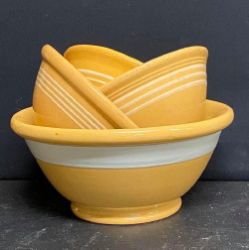Yellowware ABC's
What is Yellowware? Yellowware was the utilitarian pottery of the 1800's. This article will provide a brief history and explain types of glazes and forms which were produced. It will also list major pottery manufacturers and identifiable traits. Can add color to a modern setting as well as a decorating scheme more traditional or country. Each piece was hand-thrown in the 1800's with production switching to the use of molds in the 1920's. Each collector finds one period more attractive and interesting than the other. The following tidbits will increase your understanding as well as possibly shed light on which direction you may want to head in your collecting. We welcome all questions.
- Utilitarian pottery from yellow clay with a clear alkaline-based glaze produced in the 1800’s
- Became popular and almost a necessity due to its predecessor redware having a lead-based glaze containing toxins
- Could be found in practically every kitchen and commercial bakery as the “pyrex” of its era
- Originally produced in England in the early 1800’s
- Primarily produced in New Jersey, Pennsylvania, and Ohio in the 1800’s in the US
- Traditional English yellowware would have been more delicate and ornate.
- American yellowware is heavier and thicker with minimal decoration
- Ohio, Illinois, and Minnesota pottery companies then produced it in the 1920’s
- Bowls produced in the 1800’s will have a top rolled rim while those produced in the 1920’s will have what is called a “shoulder”
- This shoulder is the squared off top rim
- As a general rule, the fatter the top rolled rim, the earlier the piece
- 90% of the pottery is unmarked
- Pieces produced by the Yellow Rock or Jeffords pottery companies in Philadelphia will be marked with their mark, but not even all their pieces are marked
- Some Hull and McCoy pieces made in the 1920’s will be marked
- Pieces can be found with a variety of decoration from a number of stripes/bands to elaborate seaweed-decoration
- Stripes/bands can be found in a variety of colors including white, brown, and blue.
- The base color of the banding(slip glaze) would have been white and then the colors would have been achieved by adding cobalt to result in blue while manganese or tobacco spit would have been added to achieve brown
- Cobalt was very expensive so fewer pieces actually had blue bands and thus will have a higher value.
- Yellow Rock and Jeffords were considered the Neiman Marcus of the yellowware world because they would frequently add blue bands to their pieces
- What forms are available?
- Bowls ranging in size from 3” to 15” in diameter
- Creamers, pitchers, and mugs
- Baking dishes in oval and rectangular shapes in various sizes as well
- Molds with various motifs ranging from animals to geometrics
- Several other pieces for possible commercial use and special order
- Rockingham is a form of yellowware with a manganese glaze
- Some potters produced both rockingham and yellowware while others produced only one or the other
- Most prolific potter was in Bennington, VT
- Bennington is a type of rockingham and often considered the Neiman Marcus of this glaze
- Can be found in all the traditional yellowware forms as well as some other very large specialty pieces such as water coolers, foot baths, and urns
- Additional info can be found in another article on our site
- Green-glazed yellowware is often considered to be a type of yellowware as well
- The base clay is yellowware
- Produced in the 1920’s by Ohio, Minnesota, and Illinois pottery companies
- Found in shades of green glazes and elaborate embossed patterns
- When blended with the yellowware bowls, it can be an aesthetically pleasing collection
- Often when collectors opt for both colors, they will build sets where every other bowl is a different color making the 5” and 7” green while the 6” and 8” would be yellow
- Please see our other articles for the Country Home article featuring our green-glazed pieces
< Back to articles

















